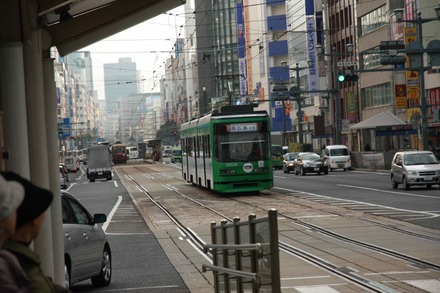
We were booked on to the 10:51 Sakura 549 service that could have taken us all the way to the day's eventual destination in Kagoshima if we hadn't decided to break the journey in Kumamoto and take a walk around the Castle there, and, as it turned out, it was just as well we hadn't opted to visit the Peace Museum.
There were other places that could well have been worth a visit on a less crowded schedule, including Just north of the city, Fudoin Temple on the east bank of the Ota River is one of the few structures in the area to survive the atomic blast and the The kondo (main hall) is the only designated national treasure in Hiroshima City. It seems the kondo was originally built in Suo Province and moved to the present site, but based on statues of the Buddha of healing and medicine within the building, it is assumed a temple had already been built by on the site by the end of the Heian period. The kondo is the largest remaining structure in the medieval Kara style, brought from south China in the Kamakura era with Zen Buddhism, in Japan. It boasts beams spanning 7.3 metres and 5.5 metres, and irimoya (a combination of gable and hip roof) with mokoshi (an extra roof). Inside, the dedication in suggests Fudoin was built around 1540.
We could also have visited Shukkeien Garden (literally, shrunken-scenery garden), which dates back to 1620, was started just after the completion of Hiroshima Castle, and features a miniaturized representation of a variety of natural formations and scenic views, depicting valleys, mountains, and forests. There are a number of tea houses around the garden's main pond which offer visitors views of the surrounding scenery and a path which winds around the pond passes through all of Shukkeien's miniaturized scenes, it would probably have been an ideal place to destress after the atomic bomb sites, but we had other fish to fry down Kagoshima way
By the time we'd made our way back to the station, hoofed it back to the hotel, where the checkout time was a very convenient eleven o'clock, collected the backpacks and the Little Red Travelling Bag and made our way back to catch the train we had all of five minutes to spare before departure.
Once on board and under way I was tempted to leave the tapping and just enjoy the scenery, since we were on the left hand side and there were issues with solar glare coming into play, but frequent tunnels made the sightseeing bit difficult and by the time we'd passed through the intervening stops and had hit the tunnel that takes the Shinkansen line onto Kyushu I was well and truly in tap it out mode.
Once we'd made our way through Hakata, however, I was inclined to sit back and enjoy the scenery, which, once we were out of the urban sprawl at the top of the island, tended towards forest-clad ridges with the odd bit of residential and farming activity in the valleys and not much of anything in the steep-sided gorges.
We tend to think of Japan as a highly urbanised country, a teeming ants nest kind of place where they employ people to pack passengers into overcrowded commuter trains, forgetting that 73% is mountainous and therefore relatively safe from urban development and 70% is forest (and natural forest, as opposed to planted forests account for 50% of the country's surface area). Madam and I had spent much of the preceding week and a half working our way around that sort of landscape in the Deep North, the relatively recently colonized Hokkaido and the mountainous centre of the country around Nagano, but I'd expected Kyushu, being in the south and relatively warmer would have been fairly closely settled.